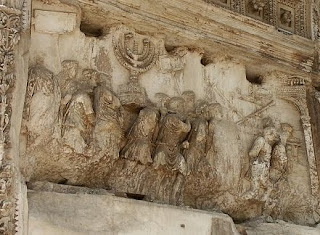The Last Ember

- detail from the Arch of Titus showing spoils from Jerusalem
My latest book from the library is The Last Ember by Daniel Levin. I'm not far into it yet but it's kind of so-so. What's lacking in the writing is somewhat made up for by the interesting subject matter - it tells of a search by good guys and bad guys for the gold Menorah taken to Rome after the sack of the Temple of Jerusalem in 70 AD, and then probably taken to Carthage by the Vandals who sacked Rome in 455, and then maybe secured by Belisarius in 515 and taken from Carthage to Justinian in Constantinople, after which it may have been sent to a Christian church in Jerusalem, where it might have been captured by the Persians in 614, but was probably instead smuggled back to Constantinople where may have lived until the crusader siege of the city in1204, whereupon it might have been taken back to Rome, languishing to this day in the secret vaults of the Vatican. Or not :)
Here's a review of the book from Biblical Archaeology Review ....
********************
The Last Ember by Daniel Levin
- Reviewed by John Merrill
The Last Ember by Daniel Levin is an archaeology adventure novel, in the same genre as, for example, King Solomon’s Mines or Raiders of the Lost Ark. As we have seen from Eric Cline’s nonfiction account of searches for lost artifacts,a there is considerable public interest in such topics, and readers who have that interest may find author Levin’s tale to their liking. Its premise is that the fabled gold menorah, thought to have been looted from the Jerusalem Temple by the Roman general (and later, emperor) Titus, in 70 A.D., was in fact saved by none other than the controversial Jewish historian Flavius Josephus. The hunt for the fabled artifact, triggered in modern time by clues in the writings of Josephus himself, involves a dashing protagonist, a not-very-transparent version—i.e., lawyer trained in classics—of the author himself. Together with his once and future girlfriend, a gorgeous Italian archaeologist, the hero traces clue after clue through a maze of plot twists, with a colorful supporting cast that features terrorists who finance their activities by selling looted artifacts, a Colombo-like Italian police inspector, and so forth.
Although the tale is imaginatively constructed, it betrays some of the stylistic cracks that are often found in a first-time author’s armor. A well-known rule of imaginative fiction is that, in order to get readers to buy in to one’s made-up plot elements, the verifiable facts of the story need to be accurate. Thus, when the hero on page 1 is found arriving in Rome on an Alitalia flight from New York at midnight Rome time, the reader who has actually made such a trip, which in fact lands at midday, will have difficulty suspending his or her disbelief of the more imaginative parts of the ensuing plot. The plot’s credibility is similarly tested when Josephus’s birth date is given as 30 A.D., when it is widely accepted (and ascertainable from Josephus’s own writings) that he was born in 37 A.D.
The novel is a cornucopia of Latin, Hebrew and contemporary Italian expressions, as well as a complex catalogue of archaeological features—some real and some imagined. It moves at rapid pace through multiple venues, with plot transitions that will alternatively thrill readers or confuse them. In the end, even the author betrays some signs of fatigue, with early promises of workmanlike phrasing degenerating into lines like the following: “... Jonathan’s voice was around them like something vibrant, moisturizing. They gasped with delight, their cataract eyes ablaze.”
In his acknowledgments, the author praises his editors, as is customary. But in places like the foregoing, readers may find themselves wishing the editors had provided a bit more input.
********************
Ouch :) I'm not sure I'd recommend the book, but I'm finding it interesting - a virtual visit to Rome and Jerusalem, with some history thrown in.


0 Comments:
Post a Comment
<< Home